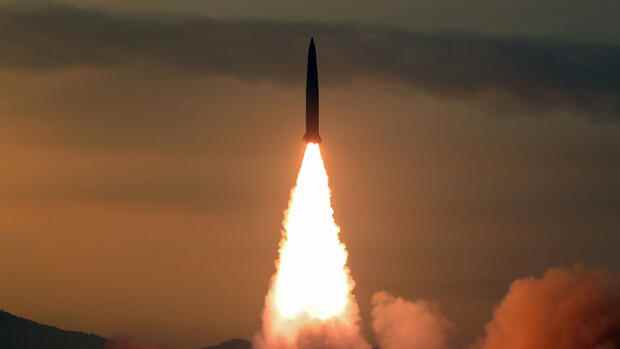Seoul North Korea’s series of missile tests does not appear to be coming to an end. This raises an important question: How can the impoverished country actually pay for it? Some experts believe that every North Korean missile launch – at least 23 in just one day last week alone – could cost the equivalent of around two to ten million euros.
Others say that realistic estimates are impossible given the country’s extreme closure, and that North Korea can probably manufacture weapons much cheaper than other countries – due to free labor and possible clandestine Chinese and Russian support.
However, there is no sign that North Korea’s economic woes are slowing down its weapons program. Ruler Kim Jong Un is determined to demonstrate that he has the capability to carry out nuclear strikes against South Korea and the US if he chooses – a bargaining chip he hopes to use to win concessions. Here’s a look at the financial dimensions of North Korea’s missile launches.
How much does each test cost?
On Wednesday and Thursday of last week alone, North Korea launched at least 29 missiles, and more were added on Saturday and Wednesday (yesterday) – after a number of missile tests that has already broken all previous records this year. In many cases, they were nuclear-capable ballistic missiles designed to destroy South Korean and US targets.
Top jobs of the day
Find the best jobs now and
be notified by email.
Soo Kim, a security analyst at the California think tank RAND Corporation, believes a North Korean test could cost anywhere from millions to $10 million. That would be cheaper than similar tests in other countries, partly because wages in North Korea are far lower.
Ruler Kim Jong Un is determined to demonstrate that he has the capability to carry out nuclear attacks against South Korea and the US if he chooses to do so.
(Photo: dpa)
Bruce Bennet, another expert at the RAND Corporation, puts the cost of each of the shorter-range missiles launched on Wednesday last week at around two to three million euros.
The total costs on this day alone are between the equivalent of around 50 and 75 million euros, as he told Radio Free Asia. According to the RFA, the estimated maximum amount is roughly equal to what North Korea spent importing rice from China in 2019 to alleviate grain shortages that year.
Lee Illwoo of the Korea Defense Network in South Korea, on the other hand, says: “There is no way for us to find out at what cost North Korea produces certain weapon parts. They could have made them themselves or China could have given them to them for free or at an extremely cheap price.”
>> Read here: Kim Arms Up – How Dangerous Is His Nuclear Program?
In a September report, the state-run Korea Institute for Defense Analyzes in Seoul estimated that North Korea had spent up to the equivalent of 1.6 billion euros on its nuclear program since the 1970s. The report used analysis of nuclear programs in other countries to calculate the figures, but some observers warn against using foreign data because the North Korean government does not have to pay for labor or land.
How are the missile tests funded?
North Korea’s economic woes have been exacerbated by the coronavirus pandemic, but there have been no reports of major social unrest or food shortages.
North Korea launched at least 29 missiles on Wednesday and Thursday last week alone.
(Photo: dpa)
When it comes to weapons development, Kim Jong Un’s party leadership has full control over the arms industry and has few budgetary constraints on national resources, according to analyst Hong Min of the Korea Institute for National Unification.
>> Read here: North Korea fires 170 artillery shells in buffer zone with South Korea
According to him, Russia’s war in Ukraine also seems to have opened up new opportunities for North Korea. He is referring to US allegations that Pyongyang is secretly supplying Russia with a “significant number” of artillery shells – and in return North Korea may seek Russian technology transfers and equipment it needs to expand its military capabilities.
What does North Korea win?
Each North Korean missile and nuclear test provides scientists with “precious data” on weapons development and helps cement Kim Jong Un’s leadership, says Kim Taewoo, former head of the Korea Institute for National Unification. At the same time, the alliance between South Korea and the USA is being challenged.
Is Russia Secretly Aiding North Korea’s Tests?
(Photo: dpa)
North Korea has argued that its missile tests are responding to joint maneuvers by the two countries, which it sees as drills for an invasion. With that in mind, testing activities are likely to continue as South Korea and the US hold regular maneuvers.
North Korea is estimated to have about 1,000 ballistic missiles, more than enough to continue its pressure campaign beyond the 2024 US presidential election in an attempt to secure sanctions lifting and other concessions, Asian Institute for Policy Studies analyst Go Myong Hyun says . By 2024, North Korea wants to demonstrate that its nuclear arsenal is very advanced and poses a much greater threat than before, Go said.
More: Korea’s New Deal shows how the state and corporations want to occupy future industries
